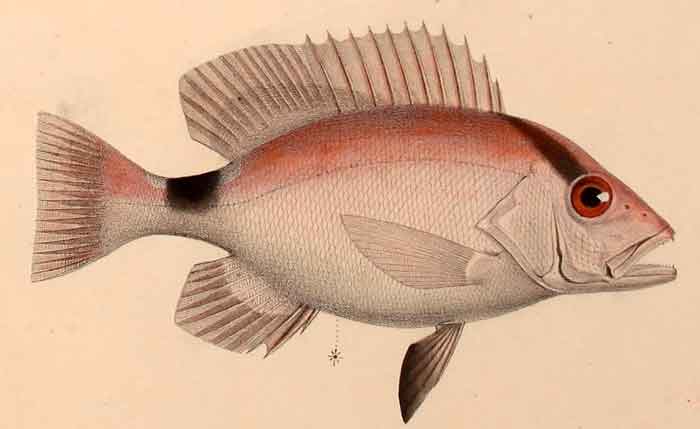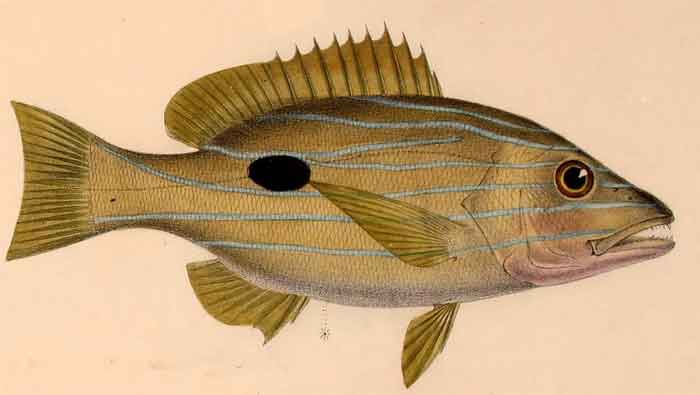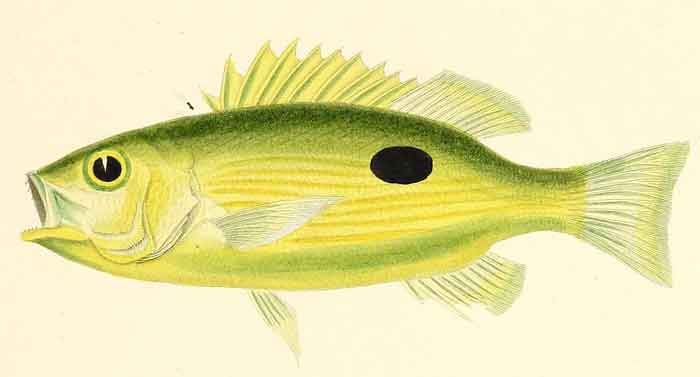Superregnum: Eukaryota
Cladus: Unikonta
Cladus: Opisthokonta
Cladus: Holozoa
Regnum: Animalia
Subregnum: Eumetazoa
Cladus: Bilateria
Cladus: Nephrozoa
Superphylum: Deuterostomia
Phylum: Chordata
Subphylum: Vertebrata
Infraphylum: Gnathostomata
Megaclassis: Osteichthyes
Superclassis/Classis: Actinopterygii
Classis/Subclassis: Actinopteri
Subclassis/Infraclassis: Neopterygii
Infraclassis: Teleostei
Megacohors: Osteoglossocephalai
Supercohors: Clupeocephala
Cohors: Euteleosteomorpha
Subcohors: Neoteleostei
Infracohors: Eurypterygia
Sectio: Ctenosquamata
Subsectio: Acanthomorphata
Divisio/Superordo: Acanthopterygii
Subdivisio: Percomorphaceae
Series: Eupercaria
Ordo: Lutjaniformes
Familia: Lutjanidae
Subfamilia: Lutjaninae
Genus: Lutjanus

Lutjanus erythropterus

Lutjanus coeruleolineatus

Lutjanus fulviflamma

Lutjanus gibbus
Species:
a-b
L. adetii – L. agennes – L. alexandrei – L. ambiguus – L. analis – L. apodus – L. aratus – L. argentimaculatus – L. argentiventris – L. bengalensis – L. biguttatus – L. bitaeniatus – L. bohar – L. boutton – L. buccanella –
c-f
L. campechanus – L. carponotatus – L. coeruleolineatus – L. colorado – L. cyanopterus – L. decussatus – L. dentatus – L. dodecacanthoides – L. ehrenbergii – L. endecacanthus – L. erythropterus – L. fulgens – L. fulviflamma – L. fulvus – L. fuscescens –
i-l
L. indicus – L. gibbus – L. goldiei – L. goreensis – L. griseus – L. guilcheri – L. guttatus – L. inermis – L. jocu – L. johnii – L. jordani – L. kasmira – L. lemniscatus – L. lunulatus – L. lutjanus –
m-q
L. madras – L. mahogoni – L. malabaricus – L. maxweberi – L. mizenkoi – L. monostigma – L. notatus – L. novemfasciatus – L. octolineatus – L. ophuysenii – L. papuensis – L. peru – L. purpureus – L. quinquelineatus –
r-x
L. rivulatus – L. rufolineatus – L. russellii – L. sanguineus – L. sapphirolineatus – L. sebae – L. semicinctus – L. stellatus – L. synagris – L. timorensis – L. viridis – L. vitta – L. vivanus – L. xanthopinnis
Name
Lutjanus Bloch 1790
Type species: Lutjanus lutjanus Bloch, 1790
Synonyms
Bennettia (subgenus of Lutianus) Fowler, 1904
Diacope Cuvier in Desmarest, 1814
Evoplites Gill, 1862
Genyoroge Cantor, 1849
Hobar (as a subgenus of Sciaena) Forsskål, 1775
Jordanichthys Evermann & Clark, 1928
Loxolutjanus (subgenus of Lutjanus) Fowler, 1931
Lutianus Bloch, 1790
Mesoprion Cuvier in Cuvier & Valenciennes, 1828
Neomaenis Girard, 1858
Neomesoprion Castelnau, 1875
Parkia (subgenus of Lutianus) Fowler, 1904
Percaprionodes (as a subgenus of Prionodes) Fowler, 1944
Rabirubia (subgenus of Lutjanus) Jordan & Fesler, 1893
Raizero (subgenus of Lutjanus) Jordan & Fesler, 1893
Rhomboplitoides Fowler, 1918
References
Bloch, M. E. 1790. Naturgeschichte der ausländischen Fische. Berlin. v. 4: i–xii + 1–128, Pls. 217–252. BHLReference page.
García-Vargas, F.; Fajer-Ávila, E.J.; Lamothe-Argumedo, M.R. 2008: Two new species of Dactylogyridae (Monogenoidea) on rose spotted snapper, Lutjanus guttatus (Osteichthyes: Lutjanidae), from the coasts of Nayarit and Sinaloa, Mexico. Zootaxa 1729: 61–68. Abstract & excerpt Reference page.
Iwatsuki, Y., Al-Mamry, J.M. & Heemstra, P.C. 2016. Validity of a blue stripe snapper, Lutjanus octolineatus (Cuvier, 1828) and a related species, L. bengalensis (Bloch, 1790) with a new species (Pisces; Lutjanidae) from the Arabian Sea. Zootaxa 4098(3): 511–528. DOI: 10.11646/zootaxa.4098.3.5.Reference page.
Victor, B.C.; Hanner, R.; Shivji, M.; Hyde, J.; Caldow, C. 2009: Identification of the larval and juvenile stages of the Cubera Snapper, Lutjanus cyanopterus, using DNA barcoding. Zootaxa, 2215: 24–36. Abstract & excerpt
Links
Lutjanus – Taxon details on Integrated Taxonomic Information System (ITIS).
Lutjanus species list in FishBase,
Froese, R. & Pauly, D. (eds.) 2022. FishBase. World Wide Web electronic publication, www.fishbase.org, version 08/2021.
Vernacular names
English: Common snappers, Snappers
日本語: フエダイ属
ไทย: ปลากะพงแดง, ปลากะพงข้างปาน
Tagalog: Maya-maya
Lutjanus is a genus of marine ray-finned fish, snappers belonging to the family Lutjanidae. They are found in the Atlantic, Indian, and Pacific Oceans. They are predatory fish usually found in tropical and subtropical reefs, and mangrove forests. This genus also includes two species that only occur in fresh and brackish waters.
Taxonomy
Lutjanus was created in 1790 by the German physician and zoologist Marcus Elieser Bloch with Lutjanus lutjanus as its type species by tautonymy.[1] It is the type genus of the subfamily Lutjaninae and the family Lutjanidae. The name is derived from a local Indonesian name for snappers, ikhan Lutjang.[2] Bloch erroneously stated that the type locality for L. lutjanus was Japan when the name he gave it suggested that it was collected in the East Indies.[3] A taxonomic study of snappers within the subfamily Lutjaninae in the tropical western Atlantic Ocean indicated that the at monotypic genera Ocyurus and Rhomboplites sit within the genus Lutjanus.[4] Lutjanus ambiguus is considered by some authorities to most likely to be a hybrid between L. synagris and Ocyurus chrysurus, supporting the close relation between the two genera.[5]
Species
Lutjanus bohar
Lutjanus ehrenbergii
Lutjanus gibbus
Lutjanus monostigma
Currently, 73 recognized species are placed in this genus:[6][7]
Lutjanus adetii (Castelnau, 1873) (yellow-banded snapper)
Lutjanus agennes Bleeker, 1863 (African red snapper)
Lutjanus alexandrei R. L. Moura & Lindeman, 2007 (Brazilian snapper)
Lutjanus ambiguus (Poey, 1860) (ambiguous snapper)
Lutjanus analis (Cuvier, 1828) (mutton snapper)
Lutjanus apodus (Walbaum, 1792) (schoolmaster snapper)
Lutjanus aratus (Günther, 1864) (mullet snapper)
Lutjanus argentimaculatus (Forsskål, 1775) (mangrove red snapper)
Lutjanus argentiventris (W. K. H. Peters, 1869) (yellow snapper)
Lutjanus bengalensis (Bloch, 1790) (Bengal snapper)
Lutjanus biguttatus (Valenciennes, 1830) (two-spot banded snapper)
Lutjanus bitaeniatus (Valenciennes, 1830) (Indonesian snapper)
Lutjanus bohar (Forsskål, 1775) (two-spot red snapper)
Lutjanus boutton (Lacépède, 1802) (Moluccan snapper)
Lutjanus buccanella (Cuvier, 1828) (blackfin snapper)
Lutjanus campechanus (Poey, 1860) (northern red snapper)
Lutjanus carponotatus (J. Richardson, 1842) (Spanish flag snapper)
Lutjanus coeruleolineatus (Rüppell, 1838) (blue-line snapper)
Lutjanus colorado D. S. Jordan & C. H. Gilbert, 1882 (Colorado snapper)
Lutjanus cyanopterus (Cuvier, 1828) (cubera snapper)
Lutjanus decussatus (Cuvier, 1828) (checkered snapper)
Lutjanus dentatus (A. H. A. Duméril, 1861) (African brown snapper)
Lutjanus dodecacanthoides (Bleeker, 1854) (sunbeam snapper)
Lutjanus ehrenbergii (W. K. H. Peters, 1869) (black-spot snapper)
Lutjanus endecacanthus Bleeker, 1863 (Guinea snapper)
Lutjanus erythropterus Bloch, 1790 (crimson snapper)
Lutjanus fulgens (Valenciennes, 1830) (golden African snapper)
Lutjanus fulviflamma (Forsskål, 1775) (dory snapper)
Lutjanus fulvus (J. R. Forster, 1801) (black-tail snapper)
Lutjanus fuscescens (Valenciennes, 1830) (freshwater snapper)
Lutjanus gibbus (Forsskål, 1775) (humpback red snapper)
Lutjanus goldiei (W. J. Macleay, 1882) (Papuan black snapper)
Lutjanus goreensis (Valenciennes, 1830) (Gorean snapper)
Lutjanus griseus (Linnaeus, 1758) (grey snapper)
Lutjanus guilcheri Fourmanoir, 1959 (yellow-fin red snapper)
Lutjanus guttatus (Steindachner, 1869) (spotted rose snapper)
Lutjanus indicus G. R. Allen, W. T. White & Erdmann, 2013[8]
Lutjanus inermis (W. K. H. Peters, 1869) (golden snapper)
Lutjanus jocu (Bloch & J. G. Schneider, 1801) (dog snapper)
Lutjanus johnii (Bloch, 1792) (John's snapper)
Lutjanus jordani (C. H. Gilbert, 1898) (Jordan's snapper)
Lutjanus kasmira (Forsskål, 1775) (common blue-striped snapper)
Lutjanus lemniscatus (Valenciennes, 1828) (yellow-streaked snapper)
Lutjanus lunulatus (M. Park, 1797) (lunar-tail snapper)
Lutjanus lutjanus Bloch, 1790 (big-eye snapper)
Lutjanus madras (Valenciennes, 1831) (Indian snapper)[9]
Lutjanus mahogoni (Cuvier, 1828) (mahogany snapper)
Lutjanus malabaricus (Bloch & J. G. Schneider, 1801) (Malabar blood snapper)
Lutjanus maxweberi Popta, 1921 (pygmy snapper)
Lutjanus mizenkoi G. R. Allen & Talbot, 1985 (Samoan snapper)
Lutjanus monostigma (Cuvier, 1828) (one-spot snapper)
Lutjanus notatus (Cuvier, 1828) (blue-striped snapper)
Lutjanus novemfasciatus T. N. Gill, 1862 (Pacific dog snapper or Pacific cubera snapper[10]
Lutjanus octolineatus (Cuvier, 1828) (white-belly snapper)[11]
Lutjanus ophuysenii (Bleeker, 1860) (spot-stripe snapper)
Lutjanus papuensis G. R. Allen, W. T. White & Erdmann, 2013 (Papuan snapper)[8]
Lutjanus peru (Nichols & R. C. Murphy, 1922) (Pacific red snapper)
Lutjanus purpureus (Poey, 1866) (southern red snapper)
Lutjanus quinquelineatus (Bloch, 1790) (five-lined snapper)
Lutjanus rivulatus (Cuvier, 1828) (blubber-lip snapper)
Lutjanus rufolineatus (Valenciennes, 1830) (yellow-lined snapper)
Lutjanus russellii (Bleeker, 1849) (Russell's snapper)
Lutjanus sanguineus (Cuvier, 1828) (humphead snapper or scarlet snapper)
Lutjanus sapphirolineatus Iwatsuki, Al-Mamry & Heemstra, 2016 (Arabian blue-striped snapper)[11]
Lutjanus sebae (Cuvier, 1816) (emperor red snapper)
Lutjanus semicinctus Quoy & Gaimard, 1824 (black-banded snapper)
Lutjanus stellatus Akazaki, 1983 (star snapper)
Lutjanus synagris (Linnaeus, 1758) (Lane snapper)
Lutjanus timorensis (Quoy & Gaimard, 1824) (Timor snapper)
Lutjanus viridis (Valenciennes, 1846) (blue and gold snapper)
Lutjanus vitta (Quoy & Gaimard, 1824) (brown-stripe red snapper)
Lutjanus vivanus (Cuvier, 1828) (silk snapper)
Lutjanus xanthopinnis Iwatsuki, F. Tanaka & G. R. Allen, 2015 (yellow-fin snapper)[9]
Characteristics
Lutjanus snappers are small to large in size with oblong shaped bodies which vary from deep to slender and fusiform in form. They have relatively large mouths which is protractable. The teeth are arranged in one or more rows in the jaws and are pointed and conical in shape with the outer row consisting of canine-like teeth with the anterior ones enlarged into more obvious canine-like fangs. The vomerine teeth are arranged in patches which may be chevron, triangular or lunate and may or may bot have a posterior extension, or be arranged in a rhombus. The space between the eyes is convex and they have a aserrated preopercle which has a deep incision on its lower margin. They sometimes jhave a bony knob between the operculum and the preopercle which is most obvious in those species which have a deep incision in the preopercle. They have a continuous dorsal fin, frequently having a slight incision between the spiny portion and the soft-rayed portion. The spiny part of the dorsal fin may have 10 or 11 spines while the soft rayed part may have 11 to 16 rays. The anal fin has 3 spines and between 7 and 10 soft rays while the pectoral fins have between 15 and 18 soft rays. The dorsal and anal fins are scaled while the caudal fin may be emarginate, truncate or, rarely, forked. These snappers are extremely variable in colour frequently having a background colour of reddish, yellow, grey, or brown overlain with a pattern of darker stripes or bars. They are often marked with a large blackish spot on upper flanks underneath the front soft rays of the dorsal fin.[12]
Distribution and habitat
Lutjanus snappers have a circumtropical and subtropical distribution and are found in the Atlantic, Indian and Pacific Oceans.[12] The mangrove red snapper (Lutjanus argentimaculatus),[13] and the dory snapper (Lutjanus fulviflamma) have been recorded in the Mediterranean as possible Lessepsian migrants having entered that sea through the Suez Canal from the Red Sea while the dog snapper (Lutjanus jocu), a western Atlantic species, has been recorded in the Ligurian Sea.[14] Many species are associated with coral reefs where they are conspicuous members of the fish fauna, while some of the larger red snapper species descend into deeper waters, at least to 200 m (660 ft) in depth.[12] 2 species, L. fuscescens and L. maxweberi, only occur in fresh and brackish waters.[7]
Biology
Smaller Lutjanus species are often observed in large, diurnal aggregations which stay near the reef, these disperse at night to feed. Their diet is largely made up of fishes and crustaceans. Group spawning has been obserbed in at least one species. Courtship is initiated by the males who peck and rub themselves on the females' body and when other individuals are attracted to the initial pair they all spiral towards the surface, releasing the milt and eggs just underneath the surface. The eggs are minute and spherical in shape and take 18 hours or so to hatch into larvae.[12]
Fisheries
Lutjanus is a genus which contains many species, especially the larger ones, which are important commercial fish and which are considered to be excellent food fish in the tropics. The catch is taken using a variety of methods including handlines, traps, spears, nets and trawling gear. They are mainly sold as fresh fish but may be preserved by freezing or dry-salted.[12]
References
Eschmeyer, William N.; Fricke, Ron & van der Laan, Richard (eds.). "Genera in the family Lutjanidae". Catalog of Fishes. California Academy of Sciences. Retrieved 27 May 2021.
Christopher Scharpf & Kenneth J. Lazara, eds. (5 January 2021). "Order LUTJANIFORMES: Families HAEMULIDAE and LUTJANIDAE". The ETYFish Project Fish Name Etymology Database. Christopher Scharpf and Kenneth J. Lazara. Retrieved 24 May 2021.
Eschmeyer, William N.; Fricke, Ron & van der Laan, Richard (eds.). "Species in the genus Lutjanus". Catalog of Fishes. California Academy of Sciences. Retrieved 27 May 2021.
John R. Gold; Gary Voelker; Mark A. Renshaw (2011). "Phylogenetic relationships of tropical western Atlantic snappers in subfamily Lutjaninae (Lutjanidae: Perciformes) inferred from mitochondrial DNA sequences". Biological Journal of the Linnean Society. 102 (4): 915–929. doi:10.1111/j.1095-8312.2011.01621.x.
William F. Loftus (1992). "Lutjanus Ambiguus (Poey), a Natural Intergeneric Hybrid of Ocyurus Chrysurus (Bloch) and Lutjanus Synagris (Linnaeus)". Bulletin of Marine Science. 50 (3): 489–500.
Allen, G. R.; Talbot, F. H. (1985). "Review of the Snappers of the Genus Lutjanus (Pisces: Lutjanidae) from the Indo-Pacific, with the Description of a New Species". Indo-Pacific fishes. Honolulu: Bishop Museum. 11: 1–87 pp., 80 col figd.
Froese, Rainer and Pauly, Daniel, eds. (2016). Species of Lutjanus in FishBase. January 2016 version.
Allen, G.R., White, W.T. & Erdmann, M.V. (2013). "Two new species of snappers (Pisces: Lutjanidae: Lutjanus) from the Indo-West Pacific" (PDF). Journal of the Ocean Science Foundation. 6: 33–51.
Iwatsuki, Y., Tanaka, F. & Allen, G.R. (2015). "Lutjanus xanthopinnis, a new species of snapper (Pisces: Lutjanidae) from the Indo-west Pacific, with a redescription of Lutjanus madras (Valenciennes 1831)" (PDF). Journal of the Ocean Science Foundation. 17: 22–42.
"Species: Lutjanus novemfasciatus, Pacific cubera snapper, Pacific dog snapper". Smithsonian Tropical Research Institute.
Iwatsuki, Y., Al-Mamry, J.M. & Heemstra, P.C. (2016): Validity of a blue stripe snapper, Lutjanus octolineatus (Cuvier 1828) and a related species, L. bengalensis (Bloch 1790) with a new species (Pisces; Lutjanidae) from the Arabian Sea. Zootaxa, 4098 (3): 511–528.
Gerald R. Allen (1985). FAO species catalogue Vol.6. Snappers of the world An annotated and illustrated catalogue of lutjanid species known to date (PDF). FAO Rome. p. 33. ISBN 92-5-102321-2.
Froese, Rainer; Pauly, Daniel (eds.) (2021). "Lutjanus fulviflamma" in FishBase. February 2021 version.
Adriana Vella; Noel Vella & Sandra Agius Darmanin (2015). "First record of Lutjanus fulviflamma (Osteichthyes: Lutjanidae) in the Mediterranean Sea". Journal of the Mediterranean/Black Sea Environment. 21 (3): 307–315.
Retrieved from "http://en.wikipedia.org/"
All text is available under the terms of the GNU Free Documentation License

